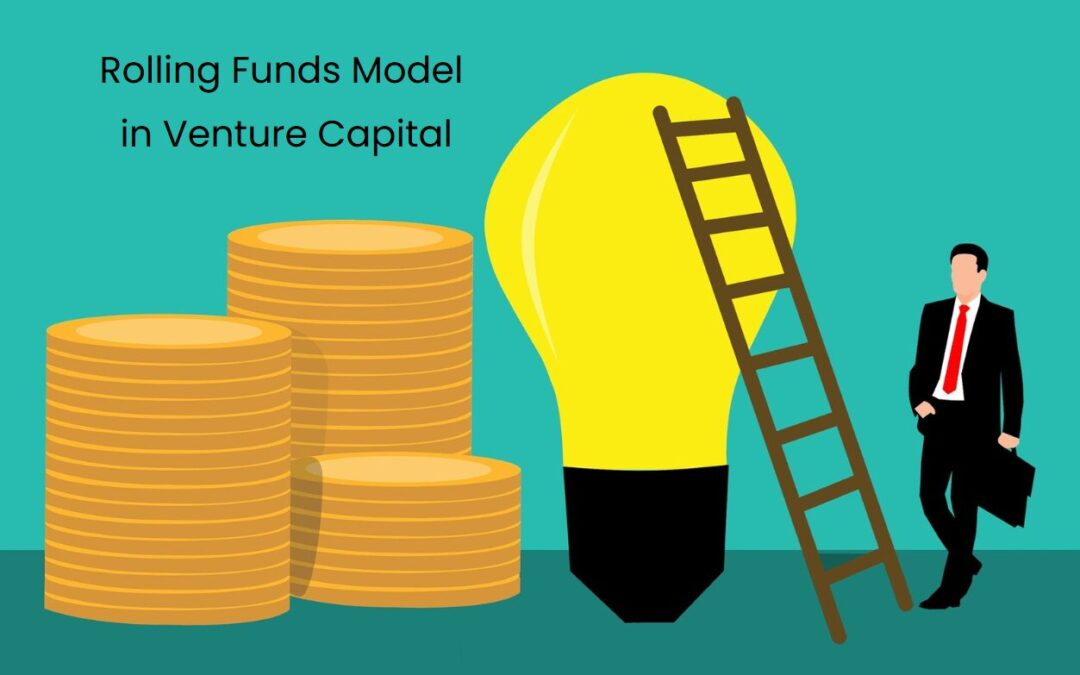Entrepreneurs looking to diversify their funding sources would want to explore the rolling funds model in venture capital. Rolling funds are the latest investment model to emerge in the rapidly evolving venture capital landscape. This capital source is quickly gaining significant interest and traction.
Investors view rolling funds as a flexible strategy for investing and deploying their capital. Founders see them as a dynamic funding source for their early-stage startups. Developed by AngelList, the rolling funds concept has shown multiple benefits for both–investors and startups.
As an early-stage startup founder, you’ll want to grasp their dynamics to craft the perfect pitch when approaching investors. Let’s dive into how they work.

*FREE DOWNLOAD*
The Ultimate Guide To Pitch Decks
Understanding the Rolling Funds Model in Venture Capital
The SEC’s Rule 506(c) governs rolling funds, an innovative investment vehicle. Investors are limited partners (LPs) in the fund who appoint a fund manager to deploy the capital. The general partner (GP) uses their discretion to make investments on behalf of the partners.
Participants in the rolling fund contribute money regularly, typically every quarter or annually. As a result, the fund’s structure evolves continually, with new funds becoming available to startups and founders. New accredited investors are welcome to join the fund at any time.
There are no restrictions on the minimum funds that accredited investors can contribute. However, it’s advisable that fund members have at least $500K available. Even if they haven’t contributed the capital, they should commit to the contribution.
These investors can be high-net-worth individuals, angels, venture capitalists, family offices, or even seasoned investors. Essentially, they are entities with capital available and interested in starting their investment journey.
They are looking for lucrative investment options and reliable professionals with the expertise to manage money. Fund managers are responsible for running the rolling fund, accepting contributions, and deploying them to earn maximum returns.
Managers can also run fundraising campaigns to attract capital to the fund. Keep an eye out for announcements since they indicate that the rolling fund will likely have capital available for deployment soon. Also, add the fund to your list of investors to approach for funding.

Raise Capital Smarter, Not Harder
- AI Investor Matching: Get instantly connected with the right investors
- Pitch & Financial Model Tools: Sharpen your story with battle-tested frameworks
- Proven Results: Founders are closing 3× faster using StartupFundraising.com
How the Rolling Funds Model Works
Members of the rolling fund sign up with new capital commitments, which auto-renew every quarter or annually. Fund managers pool the capital and invest the money in high-value investment options. The regular capital contribution ensures the fund grows consistently over time, building credibility.
Rolling funds don’t necessarily deploy all the capital available within the quarter or year. They carry the remaining funds to the next quarter or year and deploy when the right opportunities are available. But, members continue to bring in the subscribed-for capital contribution on schedule in the next quarter or year.
Rolling funds models have a fee structure similar to other fund management platforms like AngelList. Members must pay the GP or fund manager a fee for their services. However, as the fund size grows and improves efficiency and scale, the fee could decrease. Here’s what the structure looks like:
- Administration Fee: This fee covers the costs of operating the fund and includes the cost of regulatory compliance, legal charges, and administrative expenses. Most traditional funds and syndicates also charge a similar fee, which can be around 0.15%.
- Management Fee: This fee is payable to the fund manager or GP and typically ranges from 0% to 3%. Usually, this fee is 2%, but it can also be 1.5% per quarter, as at AngelList.
- Carried Interest: Once the fund’s returns cross a pre-determined threshold, the GP receives a share or percentage of the profits.
How the Rolling Funds Model Differs from Traditional Venture Capital
AngelList initially introduced the rolling funds model in 2020 as an alternative investment vehicle to traditional venture capital. The intention was to provide emerging venture capitalists with a quicker and more streamlined channel to start investing funds.
The key difference is that, unlike conventional VCs, the rolling fund can raise capital incrementally. Managers need not approach investors for a one-time high-value capital contribution and lock the money for four years or more. New investors can sign up with the fund at any time and start contributions.
- Conventional VCs typically have a lengthy and complex process to close the deal. GPs may approach multiple angel investors, family offices, and high-net-worth individuals before they have the minimum funds to start the VC firm. They need to secure a capital commitment before working. Interestingly, a traditional VC firm needs an average of 31 weeks or 8 months to raise the fund. Rolling funds follow a much shorter and quicker process.
- The rolling funds model allows fund managers to conduct their fundraising publicly. However, conventional VCs complete their contribution deals privately. Information about the fund is made public only after raising the first chunk of capital.
- Conventional VCs follow industry standards that expect them to invest capital for a 10-year cycle. They must maintain their capital commitment until it is fully closed. However, as their name suggests, rolling funds raise fresh infusions of capital every quarter or year. GPs deploy the capital as it comes in.
Why Investors Prefer Rolling Funds
Best of Both Worlds–Angel Syndicates and Conventional Venture Capital
As explained in the preceding sections, conventional venture capital contributions are lengthy and time-consuming. Once the funds are raised, the capital remains locked in for at least 10 years. Further, the firm is unlikely to raise more funding within the next two to five years.
As a result, fund managers cannot take advantage of new investment opportunities which may be more lucrative. Further, they cannot adapt to evolving market conditions and trends and make decisions to disinvest and minimize losses.
Angel syndicates, on the other hand, pool capital from high-net-worth entities and divert it toward viable opportunities. Since their investments target specific projects, fund managers must conduct thorough due diligence to identify potential red flags. This is why the investment process takes time and involves investors incurring additional expenses.
The rolling funds model eliminates the downsides since it operates on a regular contribution basis, similar to a fixed subscription. Investors must contribute capital at regular intervals, ensuring the fund receives a steady influx of cash.
Fund managers have adequate capital to deploy, which they can quickly divert toward supporting multiple startups. Thus, they constantly search for interesting and lucrative projects that can deliver substantial returns.
The startup ecosystem is dynamic and disruptive, with new entrepreneurs constantly emerging. They have exciting ideas that can bring transformative shifts in their respective fields.
All they need is capital to transform their ideas into successful businesses. By providing the required funding, rolling funds can capitalize on opportunities as they enter the market. Since they are agile and can make decisions quickly, they have the potential to earn higher returns in a shorter time.
Access to Diverse Markets
Traditional venture capital firms typically operate according to pre-determined investment criteria. They may only invest in specific verticals or companies at particular stages in their growth cycles. Or, in projects that will deliver assured returns. These factors limit the investment opportunities available to them.
Similarly, angel syndicates may have been formed to support a specific project. Individual angel investors also have personal evaluation conditions according to which they accept applications. However, rolling funds prefer to invest in a diverse portfolio of startups and early-stage companies.
As a result, they can effectively offset the risks arising from a single investment failing. This rolling funds model helps disperse and mitigate the risk factor. Fund managers can make bolder decisions and thus earn more significant returns.
Rolling funds are primarily suitable for investors who prefer to take a backseat in their investment decisions. These entities are passive investors and lack the time or expertise to develop robust investment strategies.
Thus, they entrust the task to qualified professionals who excel at analyzing startups and identifying viable projects.
Keep in mind that storytelling is everything in fundraising. For a winning pitch deck to help you here, take a look at the template created by Silicon Valley legend, Peter Thiel (see it here), which I recently covered. Thiel was the first angel investor in Facebook, with a $500K check that turned into more than $1 billion in cash.
Remember to unlock the pitch deck template that founders worldwide are using to raise millions below.
Flexibility in Investment
Rolling funds present investment opportunities to smaller investors who want to allocate smaller amounts of capital. The fund also accepts capital as low as $5,000 to $10,000. Traditional venture capital firms expect their members to dedicate large sums at a given time and for a fixed duration.
However, members of rolling funds can participate for shorter time frames. They are free to pause and resume their contribution commitments at their convenience. This flexible approach allows them to divert capital to the best opportunities available.
Investors can strategize their investments to capitalize on changing macroeconomic conditions and market shifts. They need not lock up large amounts of cash in a single VC firm for an extended period. They have better control over their investment portfolios while navigating market fluctuations.
Investors can also use the flexibility to test the GP’s expertise and success rates. If they see good returns, they’ll continue to contribute to the rolling fund. But if the returns are unsatisfactory, they can withdraw their investments.
Investors can also monitor the projects backed by the GP. Since they contribute capital every capital or quarter, they can evaluate the startup’s performance in real-time. Only startups that demonstrate potential will continue to attract capital. Investors can consistently restructure their portfolios.
While flexibility is an upside from the investor’s perspective, it is a downside for the rolling fund. GPs can never be assured of their contributions in each quarter or year. This makes the fund’s assets under management (AUM) highly volatile and uncertain.
To counter this problem, fund managers update their strategies periodically. They also build open communication lines with members to ensure consistent contributions.
Investment Opportunities for a Broader Pool of Investors
Conventional venture capital firms are geared toward high-net-worth entities with substantial capital for investing. Institutional investors, family offices, and private equity firms are other larger entities taking advantage of investment opportunities.
The rolling funds model is a more democratized approach since it accepts all kinds of accredited investors. Thanks to the option to contribute each quarter, individuals and investors with smaller chunks of capital can also invest.
In this way, they successfully support the dynamic startup ecosystem, contributing startup capital to disruptive entrepreneurs. Rolling funds may also offer services with lower management fees than conventional venture capitalist firms.
By lowering financial barriers, rolling funds enable more investors to participate in investment opportunities, thus nurturing higher capital availability. Entrepreneurs can leverage a broader pool of investors from whom to source capital.
Encouraging Upcoming Fund Managers
The rolling funds model encourages more GPs to start their own funds. Professionals with experience in the VC space can leverage platforms like AngelList to help them manage administrative tasks. They also gain access to legal assistance and other guidance.
GPs can, therefore, divert their attention to developing and exercising their expertise in managing member portfolios and designing investment strategies.
Aside from rolling funds in venture capital, what are the other types of investors for startups? I have answered your question in this video. Check it out for detailed information.
How the Rolling Funds Model Influences the Startup Ecosystem
Pre-seed or seed startups and early-stage companies may need smaller amounts of capital to get them off the ground. At this stage, founders have yet to develop their Minimum Viable Product and are testing the market, competition, and customer base.
They may not have many assets to offer as collateral and are looking for basic funding to transform their ideas into actual products. Traditional venture capitalists, private equity firms, and family offices are institutional investors who prefer to invest in established companies.
Their objective is to earn significant profits and have a clear path to an exit along with an approximate timeline. Such investors may not be interested in backing upcoming startups with disruptive ideas. Rolling funds bridge the gap by offering initial funding that entrepreneurs need.
The Takeaway!
When scouting around for investors for the startup, you’ll explore options like crowdfunding, family, friends, bootstrapping, grants, and loans. Next, you may consider accelerators and incubators, though getting accepted into these programs is highly challenging.
Since you need smaller amounts of funding at the early stages, rolling funds could be a great option. You’ll create a pitch customized for limited members and general partners of rolling funds. And research how to approach them for funding.
Watch this space since we’ll have more information for you soon.
You may find our free library of business templates interesting as well. There, you will find every template you need when building and scaling your business completely for free. See it here.





Facebook Comments